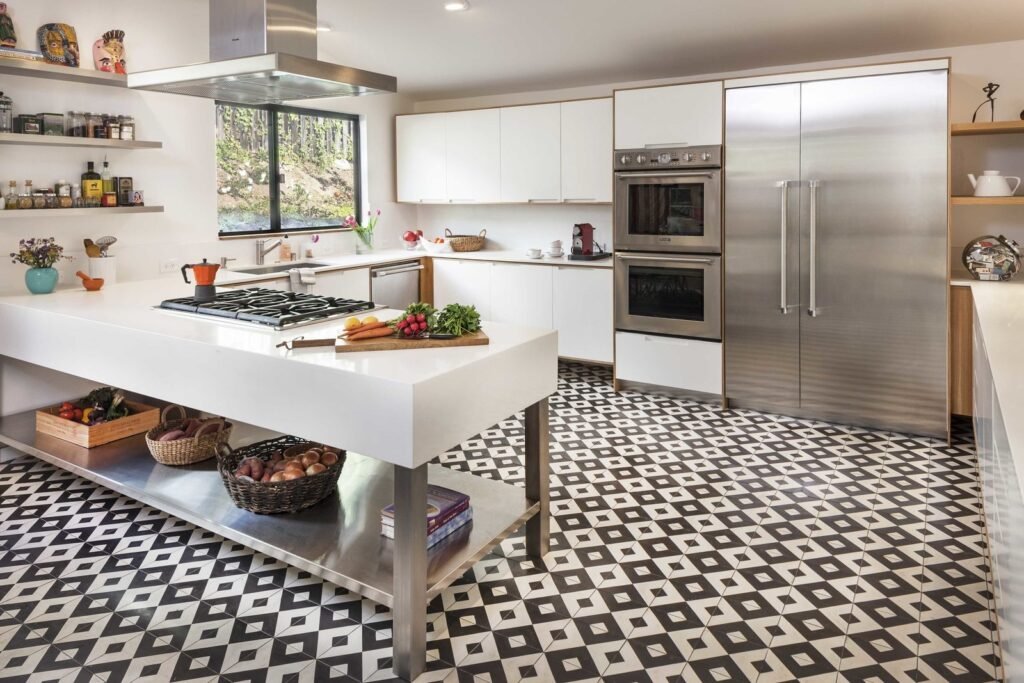The kitchen is often considered the heart of the home, a place where meals are prepared, and memories are made. One of the most impactful ways to enhance the aesthetics and functionality of your kitchen is through the strategic use of tiles. Whether you are renovating your kitchen or building a new one, choosing the right tiles can transform your space, adding beauty, durability, and easy maintenance. In this comprehensive guide, we will delve into the various aspects of Kitchen Tiles, from material selection to design tips, ensuring you make informed decisions for your kitchen upgrade.
Types of Kitchen Tiles
Ceramic Tiles
Ceramic tiles are a popular choice for kitchen flooring and backsplashes due to their affordability, versatility, and ease of maintenance. They are available in a wide range of colors, patterns, and sizes, allowing homeowners to customize their kitchen design. Ceramic tiles are also resistant to water and stains, making them ideal for the high-traffic, spill-prone kitchen environment.
Porcelain Tiles
Porcelain tiles are a type of ceramic tile that is denser and more durable. They are highly resistant to water, stains, and scratches, making them an excellent choice for kitchen floors and walls. Porcelain tiles come in various finishes, including matte, polished, and textured, providing a sophisticated look that can mimic natural stone or wood.
Glass Tiles
Glass tiles are often used for backsplashes and accent walls due to their reflective properties and vibrant colors. They can make a kitchen look more spacious and bright. Glass tiles are also non-porous, meaning they are resistant to water and stains, and they are easy to clean.
Stone Tiles
Natural stone tiles, such as granite, marble, and slate, add a luxurious and timeless appeal to any kitchen. Each stone tile is unique, with its natural veining and color variations. However, stone tiles require regular sealing to prevent staining and are more expensive than other tile options.
Mosaic Tiles
Mosaic tiles are small tiles that are often mounted on a mesh backing, making them easy to install. They are ideal for creating intricate designs and patterns on backsplashes and accent areas. Mosaics can be made from various materials, including glass, ceramic, and stone, providing endless design possibilities.
Choosing the Right Tile for Your Kitchen
Consider Your Kitchen’s Style
The style of your kitchen should significantly influence your tile choice. For a modern kitchen, sleek, large-format tiles with minimal grout lines can create a clean, seamless look. If your kitchen has a rustic or traditional feel, consider natural stone tiles or hand-painted ceramic tiles to add warmth and character.
Durability and Maintenance
Kitchen tiles should be durable enough to withstand heavy foot traffic, spills, and frequent cleaning. Porcelain and ceramic tiles are excellent for floors due to their durability and low maintenance. For backsplashes, glass tiles can be a stunning and practical choice since they are easy to wipe clean.
Color and Pattern
The color and pattern of your tiles can dramatically affect the overall look of your kitchen. Light-colored tiles can make a small kitchen appear larger and more open, while dark tiles can add depth and richness. Patterns can add visual interest, but it’s essential to balance them with the rest of your kitchen decor to avoid a cluttered look.
Tile Size
The size of the tiles can influence the room’s perception. Large-format tiles can make a small kitchen look more spacious by reducing the number of grout lines. Smaller tiles or mosaics are perfect for backsplashes or creating intricate designs.
Installation Tips
Proper Subfloor Preparation
Before installing kitchen floor tiles, ensure that the subfloor is clean, level, and properly sealed. Any imperfections can cause tiles to crack or become uneven over time.
Choosing the Right Adhesive
The type of adhesive you use depends on the tile material and the surface you are tiling. For porcelain and ceramic tiles, a latex-modified thin-set mortar is often recommended. Glass tiles typically require a white adhesive to prevent discoloration.
Grout Selection
Grout plays a crucial role in the final appearance and durability of your tiled surfaces. Epoxy grout is highly resistant to stains and water, making it ideal for kitchen areas. Choose a grout color that complements your tiles and enhances the overall design.
Sealing the Tiles
Some tiles, especially natural stone, require sealing to protect them from stains and moisture. Follow the manufacturer’s recommendations for sealing and reapplying the sealant as needed.
Design Ideas and Trends
Classic Subway Tiles
Subway tiles have been a kitchen staple for decades, offering a timeless and versatile look. They can be arranged in various patterns, such as herringbone or vertical stacks, to add a contemporary twist.
Bold Patterns and Colors
For those who want to make a statement, consider using tiles with bold patterns or vibrant colors. Moroccan-inspired tiles or geometric designs can create a focal point and add personality to your kitchen.
Mixed Materials
Combining different tile materials, such as glass and stone, can add texture and visual interest. Use glass tiles for the backsplash and stone tiles for the floor to create a harmonious yet dynamic look.
Textured Tiles
Textured tiles can add depth and dimension to your kitchen. 3D tiles or those with a raised pattern can create an eye-catching feature wall or backsplash.
Conclusion
Choosing the right tiles for your kitchen involves careful consideration of various factors, including material, durability, color, and style. By understanding the options available and how they can enhance your kitchen’s functionality and aesthetics, you can make informed decisions that will transform your space. Whether you opt for the timeless appeal of subway tiles, the luxurious feel of natural stone, or the vibrant look of glass tiles, the right choice of floor and decor tiles can elevate your kitchen to new heights of beauty and practicality.













































